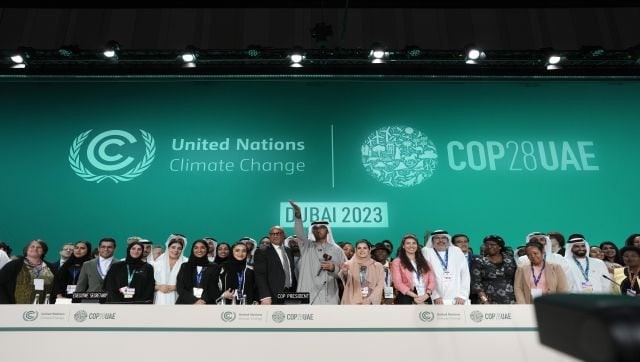Description

Disclaimer: Copyright infringement not intended.
Context
- The COP28 climate meeting delivered some important outcomes — a first-time acknowledgment of the need to move away from fossil fuels, a first promise to reduce methane emissions, operationalization and capitalization of the loss and damage fund, and an agreement on a framework for the global goal of adaptation.
- However, like all previous COPs, it remained an underachiever, unable to measure up to the expectations, particularly in galvanizing more ambitious climate action in the immediate term.
The outcomes
Fossil fuel Phase-Out:
- This was the most hotly contested issue at COP28, and the reason for a prolonged deadlock.
- The role of fossil fuels in causing global warming had never been even acknowledged in any earlier COP decision, but this was getting increasingly untenable.
- After much deliberations, the final agreement called upon countries to contribute towards “transitioning away” from fossil fuels, “so as to achieve net zero by 2050”.
- There were no time schedules and no targets. Some countries were extremely disappointed that the term “fossil fuel phase-out” had not been used.
- But even if it was, it would have a similar effect in the absence of any timeline.
- Production and consumption of fossil fuels are unlikely to be curbed significantly in the near term, but it is an important, rather unavoidable, measure in the 2050 timeframe.

Tripling of Renewable Energy:
- This was an expected outcome, and the only one that contributes to additional emission reductions between now and 2030.
- The COP28 agreement calls upon countries to contribute to tripling of global installed capacity of renewable energy, and doubling of annual improvements in energy efficiency.
- Together, these two measures have the potential to avoid emissions of about 7 billion tonnes of carbon dioxide equivalent between now and 2030, more than all the net result of all the other climate actions being currently taken.
- Tripling is a global target, and it is not incumbent on every country to individually triple its current installed capacity. It is thus not clear how this tripling would be ensured.
Phase-down of coal:
- Despite being a fossil fuel, just like oil or natural gas, coal has received a separate mention in the agreement. This is because coal was already singled out for phase-down in the Glasgow conference in 2021.
- There was a move to stipulate that no new coal fired power plants could be opened without an in-built carbon capture and storage facility, but this was strongly resisted by India, China, South Africa and other countries.
- It was dropped, and finally the Glasgow language was reiterated. There is nothing about how this phase-down is to be measured, or from what baseline.
Methane Emission Cuts:
- The agreement talks about “accelerating and substantially reducing non-cabon-dioxide emissions globally, including in particular methane emissions by 2030”.
- Methane is the most widespread greenhouse gas apart from CO2, accounting for nearly 25 per cent of all emissions. It is also about 80 times more potent than CO2 in causing global warming.
- Methane emission reductions can therefore bring substantial benefits. But several countries, including India, are extremely opposed to any mandate to cut methane emissions, mainly because one of the major sources happens to be agriculture and livestock.
- Cutting methane emissions could involve tweaking agricultural patterns which could be extremely sensitive in a country like India.
- Possibly in deference to the concerns of such countries, the agreement does not mention any targets for methane emission cuts for the year 2030, although a group of about 100 countries had made a voluntary commitment, in Glasgow in 2021, to reduce their methane emissions by 30% by 2030.
Loss and Damage Fund:
- For the poor and vulnerable countries, this was the most important outcome.
- A decision to set up a Loss and Damage Fund had been taken last year in Sharm el-Shaikh but it had not been created, and no money had been promised.
- COP28 operationalised this fund on the opening day of the conference, and several countries, including hosts UAE, made funding commitments.
- By the end of the conference, commitments worth about US$ 800 million had been made. The money is meant to provide financial help to countries trying to recover from climate-induced disasters.
.jpg)
Global Goal on Adaptation:
- This was another important step developing countries had been waiting for. Historically, adaptation hasn’t received enough attention, or resources, as compared with mitigation activities, mainly because adaptation is largely a local endeavor.
- Its benefits also are mostly local.
- But developing countries had been arguing that a global framework for adaptation was necessary to bring more attention to it.
- Accordingly, the Glasgow conference had decided to set up a two-year work programme to define the contours of this framework.
- The work program resulted in the identification of some common adaptation goals, important for the entire world.
- These included reduction in climate-induced water scarcity, attaining climate-resilience in food and agricultural production, supplies and distribution, and resilience against climate-induced health impacts.
- COP28 adopted the framework, but much more needs to be done on this front, particularly in identifying the indicators to measure progress on each of the global goals.
- The adaptation agreement currently lacks financial provisions, and countries would need to continue working on it to strengthen it in the coming years.
|
PRACTICE QUESTION
Q. Give a detailed account of the main outcomes of COP 28.
|












